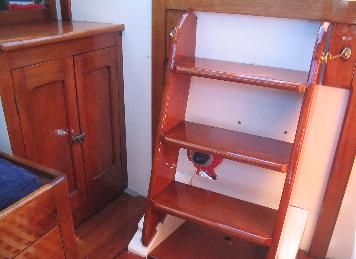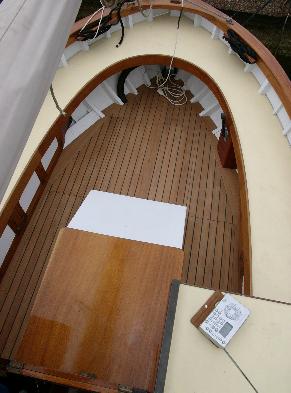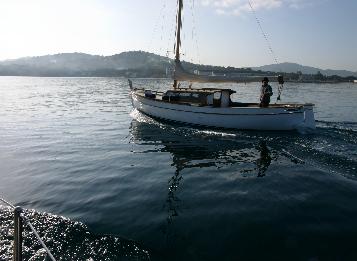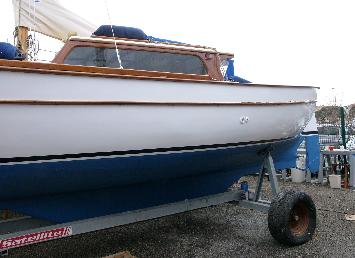


In late May St Tropez hosts Les Voiles Latine. Right in the heart of the Town, in a space normally reserved for huge motorboats you’ll find them, a gathering of nearly 50 pointus. It really does make a splendid sight. The evening sun sheds its rays across the brightly painted boats and they simply glow. It’s now the photographers come out looking for some special moment. It’s not hard to find one, since all the participants are as colourful as their boats. There’s a lot of talking. You wouldn’t think it was possible that these little boats could generate so much passion, especially when you consider that they are everything a good modern sailing boat isn’t. They are slow, wet and make leeway like you can’t believe. When they race the buoys are set up so as to have the wind on the beam all the time. However the bay of St Tropez is a notoriously difficult bay to sail in with light airs, this and the aforementioned leeway means that not many boats manage to actually get to the finish line.
I raced on Niaricoco, the boat of my good friend Jerome who is a sail maker. Not surprisingly his sails can be seen on many of the other boats too. He’s lived in St Tropez most of his life and it’s true to say he knows everyone. His boat is as immaculate as an old fishing boat can get. It even has a flush teak deck. He simply loves it and naturally has a sail inventory that would put most blue water cruisers to shame. The first year I met Jerome I did a lot of work on the boat, it was very flexible due to the rusting steel nails used to fasten the planks and had nearly sunk twice. I refastened the entire boat with bronze screws. I suspect this alone makes his boat unique but it doesn’t stop there.
Niaricoco is a Tarquié. The main difference is that whereas most Pointus are latine rigged the Tarquié has a spritsail and is unique to St Tropez. Only 3 examples are known to survive. The other difference is a subtle but important one. Look at the frames and you’ll see that they were not laid in the easiest fashion. All the frames’ forward and aft ends are cut perpendicular to the keel. It’s easiest to see at the bows and at the stern. She was built in 1927 on the beach in St Tropez and was owned by the same family until Jerome bought her a few years ago. It’s hard to say how much of boat is original as pointus are not well built boats, fastened with steel nails into short and often poor quality planks of pine onto halved frames of oak.
The deck of a Pointu is very low but some protection is offered by the high bulwarks which flare at the bows to stop waves entering the boat. They are extremely efficient at keeping small waves out and stopping the boat dead. Pointus generally have no overhangs and the rudder is removable. Many have petrol engines fitted which are old and noisy and in Jerome’s case over 50 years old. Due to the shallow draft there’s not much room for a propeller but they put one in anyway and usually as big as possible. Often when not underway, the tip of a blade can be seen poking out of the water. Once on the move the boat’s wave quickly climbs the stern and the prop becomes well submerged. In port manoeuvring a pointu is always accompanied by much noise and white water as the barely submerged prop thrashes the surface.
It is possible to buy a modern fibreglass version and it’s very nice too. I didn’t ask the price but it’s made locally and very nicely finished and about 7 metres long. Some pointus are tiny only about 5 metres and some are large at about 11 metres but the most common size seems to be between 6 and 8 metres. There are even famous pointus, Piou Piou was owned by Bridget Bardot who lives in St Tropez and it can be seen many times in the film “When God Created Women”.
One feature common to all pointus is Le Capion. It is, put simply, a phallus. A symbolic offering to Neptune asking in return, safe passage and good fishing. No one knows for sure where Capions originated but it’s widely believed that Greek settlers to the area more than 2000 years ago were responsible. However it began there’s no denying it’s popularity and spread across the entire Mediterranean Sea.
The racing was a hoot. St Tropez harbour is a busy one even in May and even getting out has its moments but what a sight on the water. There’s no denying that the Latine rig is beautiful. Like a gigantic butterfly wing dwarfing the low hull underneath it. They are an efficient rig too. Many boats have a bowsprit and fly a little jib. What is not efficient, at least to windward, is the hull shape. With the wind anywhere from behind these boats really can move and their motion is comfortable but try to go to windward and you will soon discover what a keel is for. Some of the faster Italian entries have very deep rudders which must help but for the most part little thought has gone in to wind ward performance.
Being a sail maker Jerome is well placed to see what difference a bevy of sails make but we soon learnt that the sprit sail has limitations, there is only a small leading edge and a large part of the sail is at the back of the boat which just pushes the boat sideways when you try to go to weather. With a little speed up on a flat sea, it possible to point perhaps as high as 60 degrees with maybe 10 to 15 degrees of leeway. With patience it is possible to get home again. If it’s rough then you’ll never do it. The most recent addition to the sail wardrobe is as Jerome called it his “foc ballon” or balloon jib. He’s not fooling anyone of course, it’s a high tec, laser cut and glued lightweight spinnaker. Many was the comment, “c’est joli le spi”. Jerome always replied, “non, c’est un foc ballon”. If this was serious racing someone would surely protest but here it’s merely “tres amusant”.
Another amusing aspect of pointu racing is coming about. To gibe or to tack? Gybing is easy but slow. Tacking is difficult but slow. We usually opted to tack, habit being hard to break. It went something like this: Get speed up, put the helm over and let the jib fly. Then, if someone goes forward and backs the jib right out and if the person on the helm swings the rudder frantically from side to side we can often come about and be sailing again in about one minute.
The whole event is paid for by the town of St Tropez and is said to cost about £150,000. Entrance is free and infact they even paid for the Tunisians to come over. There is a fantastic Bouillabaisse on the first night. 200 people gather to partake in this noisy, traditional nosh up. Fish soup is followed by an amazing array of seafood presented on a huge cork platter. The wine supply is endless and there was even a tarte Tropezienne to finish off with. Then at the end of the regatta is the prize giving held in glorious sunshine on the beach with yet more food and wine. We won our class and Jerome was delighted. He was even more delighted still, when the visiting Sardinians invited him and Niaricoco to Stintino to compete in a regatta there in August. All expenses paid. It’s alright for some.

